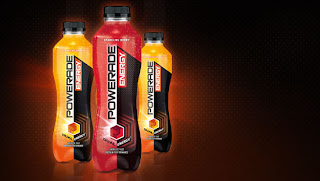The goal of a sports drink is to keep athletes hydrated and
fueled during games, training, or any physical activity. These beverages are now formulated to be consumed before, during, and after physical exertion. Because there are so many drinks available for purchase, it's hard to know which one to get, for what purpose, and when to drink them!!
In general, a sports drink contains water, a source of electrolytes (salt, minerals, etc.) and a source of carbohydrates (sugar). And, each drink has a special formula designed for a specific purpose- whether it's for hydration or recovery. Originally, the ratio of the water:carbohydrates:electrolytes was supposed to be the same/similar to sweat, with the idea that as you drink your sports drink, you are consuming the same balance of electrolytes in your drink as those which leaving your system in sweat (perfect recovery- your body doesn't get dehydrated nor does it get
hyponatremiac (meaning it has too little salt- also called "water intoxicated").
But- there are really 3 different types of sports drinks (isotonic, hypertonic, and hypotonic), and they each play a different role in the body's hydration and recovery process.
A hypotonic
sports drink is one that has less electrolytes than your own body fluids. Water moves by osmosis and goes towards the area with more concentration (to keep your body in homeostasis or balanced). So, when you drink something that is hypotonic (less concentrated) the water in the drink goes into your cells (which are more concentrated), and your body is most efficiently hydrated. Essentially, hydration occurs almost simultaneously as you drink. Hypotonic drinks are best and most effective when consumed before an event. The best example is water but watered-down sports drinks work, or anything "light" like Gatorade G2, Powerade Zero.
 |
| isotonic sports drinks are good to replenish and recover |
An isotonic sports drink is one that contains fluid and up to 8% of carbs (ideally glucose) and electrolytes. This is a similar concentration of water, sugar, and salt in your body which means that they replenish anything that was lost in sweat. The water from the drinks is absorbed well, but when you drink these isotonic drinks you also provide important electrolytes (necessary for all body functions) and carbohydrates (an important source of energy) which help you maintain energy levels throughout the activity. These are best to be used during and after an event. Gatorade, Powerade, Accelerade, most commercially available sports drinks, etc are examples
 |
| hypertonic solutions |
A hypertonic sports drink then is one that has more carbs and electrolytes than your body. The increased particle concentration is essential for athletes to replenish glycogen stores; however, they are absorbed the slowest (think- opposite of hypotonic). These are most often used as energy supplements after heavy and intense exercise. Examples of these are the drinks that say high carb/high energy/high calorie, "endurance," "performance," or plain fruit juices, etc.
So why do I care what drink I drink and when?











